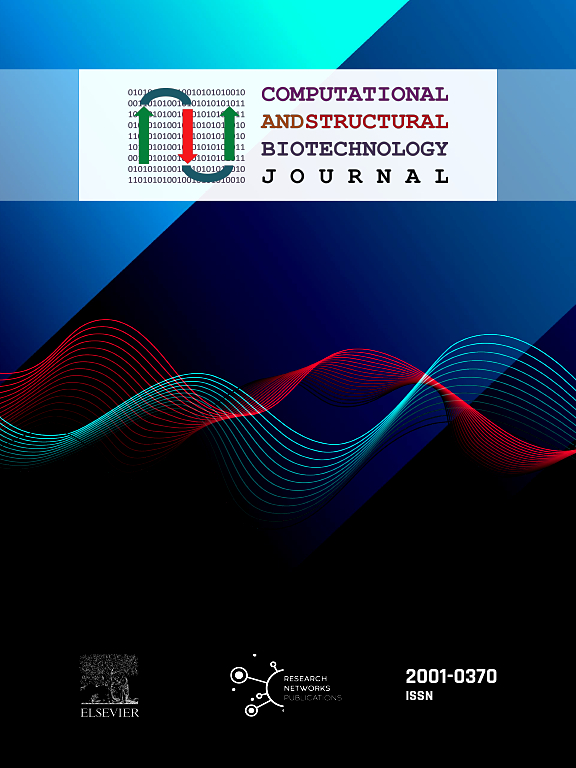Mapping Cell Identity from scRNA-seq: A primer on computational methods
IF 4.4
2区 生物学
Q2 BIOCHEMISTRY & MOLECULAR BIOLOGY
Computational and structural biotechnology journal
Pub Date : 2025-01-01
DOI:10.1016/j.csbj.2025.03.051
引用次数: 0
Abstract
Single cell (sc) technologies mark a conceptual and methodological breakthrough in our way to study cells, the base units of life. Thanks to these technological developments, large-scale initiatives are currently ongoing aimed at mapping of all the cell types in the human body, with the ambitious aim to gain a cell-level resolution of physiological development and disease. Since its broad applicability and ease of interpretation scRNA-seq is probably the most common sc-based application. This assay uses high throughput RNA sequencing to capture gene expression profiles at the sc-level. Subsequently, under the assumption that differences in transcriptional programs correspond to distinct cellular identities, ad-hoc computational methods are used to infer cell types from gene expression patterns. A wide array of computational methods were developed for this task. However, depending on the underlying algorithmic approach and associated computational requirements, each method might have a specific range of application, with implications that are not always clear to the end user. Here we will provide a concise overview on state-of-the-art computational methods for cell identity annotation in scRNA-seq, tailored for new users and non-computational scientists. To this end, we classify existing tools in five main categories, and discuss their key strengths, limitations and range of application.
通过 scRNA-seq 测绘细胞特征:计算方法入门指南
单细胞(SC)技术标志着我们在研究细胞--生命的基本单位--方面取得了概念和方法上的突破。得益于这些技术的发展,目前正在进行的大规模计划旨在绘制人体所有细胞类型的图谱,其雄心勃勃的目标是获得生理发育和疾病的细胞级分辨率。由于其广泛的适用性和易于解释的特点,scRNA-seq 可能是最常见的基于 sc 的应用。这种检测方法利用高通量 RNA 测序捕捉 sc 级的基因表达谱。随后,根据转录程序的差异与不同细胞特性相对应的假设,使用临时计算方法从基因表达模式推断细胞类型。为完成这项任务,人们开发了多种计算方法。然而,根据基本算法方法和相关计算要求的不同,每种方法都可能有特定的应用范围,而最终用户并不总是很清楚其中的含义。在此,我们将简要概述用于 scRNA-seq 中细胞身份注释的最先进计算方法,以方便新用户和非计算科学家使用。为此,我们将现有工具分为五大类,并讨论它们的主要优势、局限性和应用范围。
本文章由计算机程序翻译,如有差异,请以英文原文为准。
求助全文
约1分钟内获得全文
求助全文
来源期刊

Computational and structural biotechnology journal
Biochemistry, Genetics and Molecular Biology-Biophysics
CiteScore
9.30
自引率
3.30%
发文量
540
审稿时长
6 weeks
期刊介绍:
Computational and Structural Biotechnology Journal (CSBJ) is an online gold open access journal publishing research articles and reviews after full peer review. All articles are published, without barriers to access, immediately upon acceptance. The journal places a strong emphasis on functional and mechanistic understanding of how molecular components in a biological process work together through the application of computational methods. Structural data may provide such insights, but they are not a pre-requisite for publication in the journal. Specific areas of interest include, but are not limited to:
Structure and function of proteins, nucleic acids and other macromolecules
Structure and function of multi-component complexes
Protein folding, processing and degradation
Enzymology
Computational and structural studies of plant systems
Microbial Informatics
Genomics
Proteomics
Metabolomics
Algorithms and Hypothesis in Bioinformatics
Mathematical and Theoretical Biology
Computational Chemistry and Drug Discovery
Microscopy and Molecular Imaging
Nanotechnology
Systems and Synthetic Biology
 求助内容:
求助内容: 应助结果提醒方式:
应助结果提醒方式:


